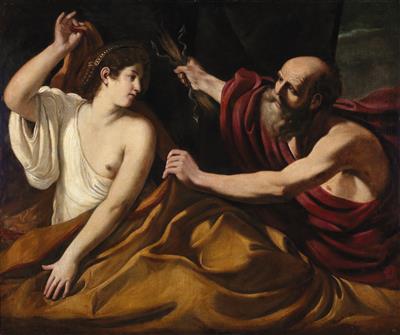Giovanni Francesco Barbieri, called il Guercino and Workshop

(Cento 1591–1667 Bologna)
Jupiter and Semele
oil on canvas, 136.5 x 164 cm, framed
We are grateful to Nicholas Turner for suggesting the attribution.
The present painting relates to a composition, known from an engraving by Giovanni Battista Pasqualini (1595–1631), published in 1626 (see fig. 1). An inscription on the print credits Guercino as the inventor of the design. Two drawings by Guercino made around this time also relate to this invention. One is a pen study, a ‘primo pensiero’ for the whole composition, in the Royal Library, Windsor Castle; and the other, a chalk study for the figure of Semele, in the Albertina, Vienna.
The pose of Jupiter in the present composition echoes that of Guercino’s Joseph in the Rest on the Flight into Egypt, in his fresco decoration of the cupola and drum of Piacenza Cathedral painted 1627. In the present composition, the deep burgundy of Jupiter’s robe and the golden-ochre of Semele’s bedding recall the rich, sombre colours of Guercino’s Roman canvases. In contrast, the slender, starkly silhouetted arms of the protagonists, clothed in deeply sculpted draperies are reminiscent of Guercino’s prophets in the triangular segments of the cupola of Piacenza Cathedral. Details, such as Semele’s face imply a possible intervention by Guercino himself.
In many later half-length paintings by Guercino the bedroom forms the backdrop to various dramatis personae who act out the continuous sexual struggle between man and woman, such as Joseph and Potiphar’s Wife, in the Zanasi Foundation, which the artist painted in 1631 for Francesco I, d’Este, duke of Modena. Other variants of the Jupiter and Semele composition are Guercino’s Venus, Cupid and Mars, in the Pinacoteca Estense, Modena, painted in 1633, and the pendants Joseph and Potiphar’s Wife and Amnon Expelling Tamar, painted in 1649, now in the National Gallery, Washington.
Additional image:
Giovanni Battista Pasqualini after Giovanni Francesco Barbieri, called il Guercino, Jupiter und Semele, engraving,
Albertina, Wien (HB 41.1, fol. 60,102)
© Albertina, Wien
20.10.2015 - 18:00
- Dosažená cena: **
-
EUR 37.500,-
- Odhadní cena:
-
EUR 15.000,- do EUR 20.000,-
Giovanni Francesco Barbieri, called il Guercino and Workshop
(Cento 1591–1667 Bologna)
Jupiter and Semele
oil on canvas, 136.5 x 164 cm, framed
We are grateful to Nicholas Turner for suggesting the attribution.
The present painting relates to a composition, known from an engraving by Giovanni Battista Pasqualini (1595–1631), published in 1626 (see fig. 1). An inscription on the print credits Guercino as the inventor of the design. Two drawings by Guercino made around this time also relate to this invention. One is a pen study, a ‘primo pensiero’ for the whole composition, in the Royal Library, Windsor Castle; and the other, a chalk study for the figure of Semele, in the Albertina, Vienna.
The pose of Jupiter in the present composition echoes that of Guercino’s Joseph in the Rest on the Flight into Egypt, in his fresco decoration of the cupola and drum of Piacenza Cathedral painted 1627. In the present composition, the deep burgundy of Jupiter’s robe and the golden-ochre of Semele’s bedding recall the rich, sombre colours of Guercino’s Roman canvases. In contrast, the slender, starkly silhouetted arms of the protagonists, clothed in deeply sculpted draperies are reminiscent of Guercino’s prophets in the triangular segments of the cupola of Piacenza Cathedral. Details, such as Semele’s face imply a possible intervention by Guercino himself.
In many later half-length paintings by Guercino the bedroom forms the backdrop to various dramatis personae who act out the continuous sexual struggle between man and woman, such as Joseph and Potiphar’s Wife, in the Zanasi Foundation, which the artist painted in 1631 for Francesco I, d’Este, duke of Modena. Other variants of the Jupiter and Semele composition are Guercino’s Venus, Cupid and Mars, in the Pinacoteca Estense, Modena, painted in 1633, and the pendants Joseph and Potiphar’s Wife and Amnon Expelling Tamar, painted in 1649, now in the National Gallery, Washington.
Additional image:
Giovanni Battista Pasqualini after Giovanni Francesco Barbieri, called il Guercino, Jupiter und Semele, engraving,
Albertina, Wien (HB 41.1, fol. 60,102)
© Albertina, Wien
|
Horká linka kupujících
Po-Pá: 10.00 - 17.00
old.masters@dorotheum.at +43 1 515 60 403 |
| Aukce: | Obrazy starých mistrů |
| Typ aukce: | Salónní aukce |
| Datum: | 20.10.2015 - 18:00 |
| Místo konání aukce: | Wien | Palais Dorotheum |
| Prohlídka: | 10.10. - 20.10.2015 |
** Kupní cena vč. poplatku kupujícího a DPH
Není již možné podávat příkazy ke koupi přes internet. Aukce se právě připravuje resp. byla již uskutečněna.
